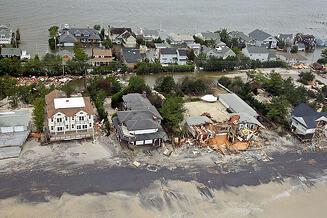 It turns out shipping containers – those modular miracles of international commerce – are suited to more than just safely storing ocean freight cargo.
It turns out shipping containers – those modular miracles of international commerce – are suited to more than just safely storing ocean freight cargo.
You may have heard of the trend of re-vamping old shipping containers, cleverly converting them into all kinds of coolness. But now they could provide disaster relief in the wake of Hurricane Sandy.
The previously unfashionable hulks of corrugated steel have been known to moonlight as modern homes and chic coffee shops, more-and-less successful sculptures, and trendy hotels. If you are into that, then check out this website:
http://webecoist.momtastic.com/2009/04/05/15-awesome-ways-to-reuse-shipping-containers/
This is all very cool given shipping containers’ short lives and prevalence. Shipping containers are only in circulation for about 5 years as freight hauling pods before they are retired to sit and rust in shipyards.
Engineers are taking recycling to a whole ‘nother level by carving up abandoned containers, often furnishing the insides, and breathing second life into these otherwise ugly shells.
But as far as practical application goes, the shipping container reincarnations seemed out-of-reach, a novelty only the rich could afford and the eco-groovy would care about. No longer.
Recent events like Hurricanes Katrina and Sandy have provided the impetus to make the dream of the practical shipping container domicile one giant leap closer to reality – like New York Mayor Bloomberg using them in his disaster housing plan.
Recently the Observer published an article about preparations by New York City administrators to instead of loading shipping containers with goods, use them as temporary emergency housing units after future disasters.[1] After sponsoring a contest for designs for just such provisional housing – called What If NYC – the converted shipping container was declared the winner.
The shipping containers are hardly recognizable as such from the inside, having been (dare I say) rather lavishly furnished.
The pictures[2] of the prototype are lovely and show surprisingly spacious rooms filled with light. They have a somewhat larger than ship’s cabin feel about them but the same efficient use of space I associate with nautical design.
The example unit is described thus, “On one end would be the bedroom, with a bed, dresser, nightstands, probably a lamp or two. On the other end is the living-dining room, with couch, table, maybe an easy chair, and a small kitchen complete with pots, pans, china and flatware. In between is the bathroom, stocked with clean towels, soap, toothbrushes, even toothpaste.”
 The idea is that the temporary domiciles would be equipped with all the basics so someone who just watched their home get demolished by a storm like Sandy could walk into a clean, safe space to take a shower and cook a meal and slowly put their life back together.
The idea is that the temporary domiciles would be equipped with all the basics so someone who just watched their home get demolished by a storm like Sandy could walk into a clean, safe space to take a shower and cook a meal and slowly put their life back together.
The container homes are made to run either on or off the power grid (with the help of generators) and even have their own septic systems to process human waste. The prototype provides 450 square-feet of living space within a 40-foot long by 8 foot wide shipping container. Designers project that they will cost between $50,000 and $80,000 for each module.
More than just functional, the designers went above and beyond, considering the aesthetics of the space and including decorative details like prints of Picasso on the bathroom walls. Windows and doors are built into both ends of the unit, both for safety (multiple exits are required by the fire department) and for light.
One of the people interviewed, David Burney, commissioner of the Department of Design and Construction, summed it up saying, “It’s nicer than my apartment”.
The shipping container-as-emergency-housing is especially suited to providing shelter to urban dwellers after natural disasters like Hurricane Sandy for two big reasons. They are compact and stackable. Plans exist for emergency apartment blocks composed of shipping container modules stacked four containers high, and as many as 12 containers wide. Four of these blocks assembled around a courtyard-like space in the center would create a ready-made apartment complex.
All things considered, the plans seem pretty smart and efficient. The cost seems high to me, but I won’t get into the budget of FEMA and don’t think those who have lost their homes will be complaining that too much was spent on providing them with a temporary domicile. In fact, I am not sure they would be able to pry me from one even after the disaster had passed, because for me (as for Mr. Burney) these shipping container temporary homes are nicer than my apartment.
